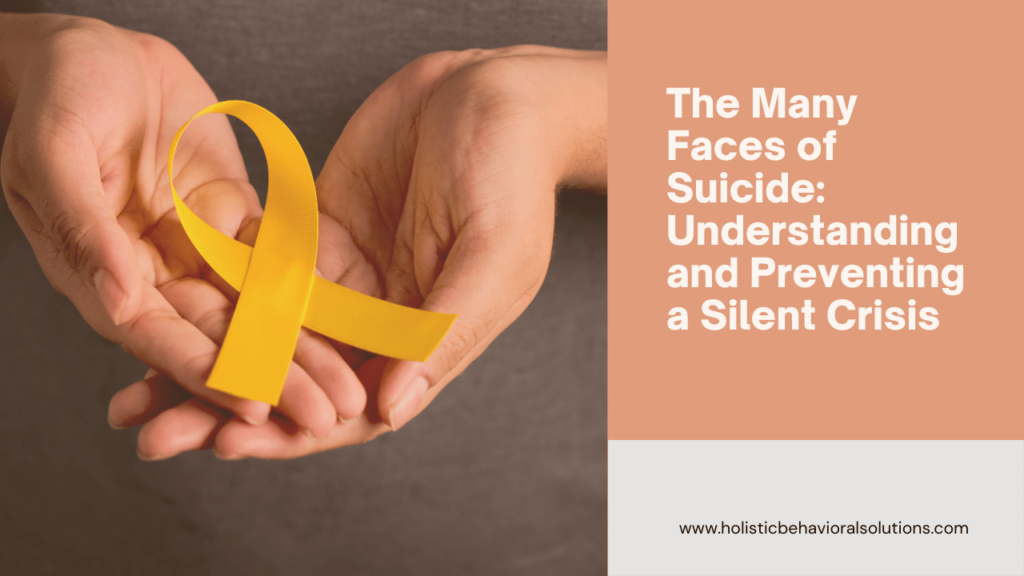
Suicide is a deeply complex and often misunderstood experience. It crosses every boundary—race, age, gender, culture, and socioeconomic status. What does suicide look like? It looks like success, struggle, joy, despair. It looks like someone in your community, someone you love—or even the person in the mirror.
We remember names like Kurt Cobain, Junior Seau and Mindy McCready. But suicide isn’t only about celebrities. It is a mirror that reflects the pain many live with daily, often in silence. Self-harm and suicidal ideation are not anomalies; they are part of a broader, quieter epidemic that touches lives everywhere.
Suicide: A Leading Cause of Death in the U.S.
Suicide is currently recognized as the 10th leading cause of death in the United States, yet many deaths go unreported or misclassified. The weight of this crisis is generational. Take country artist Mindy McCready, who died by suicide in 2013, leaving behind two young children. Stories like hers underscore the heartbreaking truth: suicide is not isolated to one moment—it creates ripples of trauma that stretch across families and generations.
As clinicians, we know that family history matters. A history of suicide in the family increases risk. But just as importantly, it highlights the need for early intervention, open conversation, and compassionate support.
Recognizing the Signs and Myths
It’s a common misconception that suicide is always driven by depression. In reality, impulsivity, hopelessness, and the inability to tolerate distress are often more dangerous precursors. Mood fluctuations, especially during seasonal changes or life transitions, must be taken seriously.
Warning signs include:
- Sudden changes in behavior or mood
- Withdrawal from social circles
- Increased substance use
- Expressions of hopelessness or worthlessness
Exposure to others’ self-harm (including in media or personal networks) can create a contagion effect. That’s why it’s essential to recognize emotional distress early and take action.
Intervention Can Save Lives
If someone you love is showing signs of emotional crisis, don’t wait. Escort them to the nearest emergency room or call the Suicide and Crisis Lifeline at 988. Help is available 24/7, and intervention can make the difference between life and death.
Therapists monitor risk factors constantly—including impulsivity, frustration tolerance, and emotional regulation. Family members must also stay tuned in. Ask questions. Look for changes. Show up with empathy.
One Step at a Time: Healing and Hope
The road out of suicidal thoughts is not a straight line. Healing happens gradually. The goal isn’t to solve everything at once—it’s to survive today. Just today.
In moments of darkness, focus on small, sustaining actions: connect with someone, eat a nourishing meal, sit outside, or speak to a therapist. These tiny steps are the building blocks of hope. And hope, once sparked, is powerful.
A Collective Responsibility
Suicide prevention is not just the work of clinicians—it’s a community commitment. We must create spaces where people feel seen, supported, and safe. Ask the hard questions. Offer a listening ear. Let people know they matter.
You don’t have to have all the answers. But you can help someone find the right support.
Need Immediate Help?
If you or someone you know is struggling, call or text the Suicide and Crisis Lifeline at 988. You are not alone, and help is always available.
The Holistic Store
While we’re thinking this through, nurture your well-being from the inside out. Explore our wellness supplements and supplies—products designed to help you feel your best, build resilience, and connect more deeply with yourself and others.
PS: Are you a culturally competent licensed clinician passionate about guiding others toward resilience? Our practice is growing, and we’re hiring in New Jersey! Check out our Careers page for current openings and join a team dedicated to fostering impactful, inclusive mental health support.

